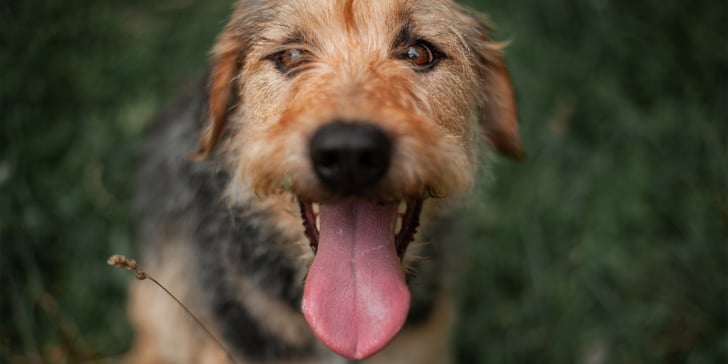Dog Breathing Fast - Why Is It Happening?
Index:



Introduction
In the realm of canine health, the phenomenon of rapid breathing in dogs, (formally termed tachypnea) is a matter of significant concern for pet parents. Recognising the underlying causes behind this respiratory pattern is important, as it often serves as a crucial indicator of potential health issues.
From benign factors like heat and stress to more serious conditions such as respiratory tract disorders or cardiac ailments, understanding the diverse triggers for rapid breathing is essential for responsible pet ownership.
This article delves into the various causes of tachypnea in dogs, emphasising the importance of prompt veterinary care and the early identification of symptoms to ensure optimal canine well-being.
What is normal breathing in dogs?



In general, a healthy dog exhibits a normal breathing rate ranging from 15 to 30 breaths per minute. However, it's crucial to recognise that individual factors such as age, size, breed, and activity level can influence these figures.
Puppies and smaller breeds, for instance, tend to have faster respiratory rates, while larger breeds may breathe more slowly. Normal panting can also occur during or after physical activity or in response to heat.
Factors like environmental temperature and stress levels can also elevate a dog's breathing, emphasising the importance of considering the broader context when assessing their respiratory health.
To accurately gauge your dog's respiratory rate, observe them in a relaxed state, preferably when they are breathing at rest or breathing during sleep.
Count the number of complete breaths (inhalation and exhalation) over the course of one minute. Alternatively, you can count for 15 seconds and multiply by four to obtain the breaths per minute. An abnormal respiratory rate may appear as breathing significantly faster or slower than the established normal range.
Rapid breathing (tachypnea) or unusually slow breathing (bradypnea) can be indicative of underlying health issues and should prompt further investigation by a veterinarian.
Common causes of rapid breathing in dogs
Stress:
Stress can induce rapid breathing in dogs as part of the "fight or flight" response. When a dog encounters a stressful situation, the body releases stress hormones, triggering an increase in respiratory rate.
Common symptoms include faster breathing, and in some cases, open-mouthed breathing. Chronic stress can have detrimental effects on a dog's overall health, making it essential for owners to identify and manage stressors.
Heat stroke:
Dogs regulate their body temperature through panting, but excessive heat can overwhelm their cooling mechanism, leading to heat stroke.
Rapid breathing, along with other symptoms like excessive panting, lethargy, and drooling, may indicate heat stroke.
This condition is a medical emergency, requiring immediate cooling measures and veterinary attention to prevent organ damage.
Heart failure:
Heart failure can result in poor circulation and inadequate oxygen supply to the body, leading to rapid breathing. Dogs with heart failure may display symptoms such as coughing, lethargy, and difficulty exercising.
Congestive heart failure, a common heart condition in dogs, requires careful management and lifelong treatment to improve the quality of life.
Respiratory infections:
Respiratory infections affecting the respiratory tract, such as pneumonia or bronchitis, can cause rapid breathing in dogs. Symptoms may include coughing, nasal discharge, and lethargy.
Bacterial, viral, or fungal agents can cause respiratory infections, and prompt veterinary diagnosis and appropriate treatment, which may include antibiotics or antifungal medications, are crucial for recovery.
Understanding the nuanced signs and potential causes of rapid breathing in dogs allows pet parents to respond promptly to their pets' needs. Regular veterinary check-ups, awareness of environmental factors, and swift action in emergencies will contribute to the overall well-being of your dog.
When rapid breathing is a medical emergency



Identifying when rapid breathing in a dog constitutes an emergency involves recognising a combination of signs that indicate underlying health issues.
Lethargy is a significant red flag; if a dog is unusually tired or unwilling to engage in activities, it may suggest a serious health concern.
Persistent coughing, especially when accompanied by rapid breathing, can indicate respiratory distress or heart-related issues.
Discharge from the nose or eyes, particularly if it is discoloured or accompanied by other symptoms, may signify infection or other medical issues.
Observing changes in gum colour is also crucial; pale or bluish gums can indicate inadequate oxygenation and potential cardiovascular problems.
In an emergency, any one of these signs, or a combination of them, should prompt immediate veterinary intervention.
Various types of rapid breathing patterns can offer insights into potential causes. Tachypnea, rapid and shallow breathing, may suggest conditions like heat stroke, pain, or respiratory distress. On the other hand, dyspnea, characterised by difficulty breathing or laboured breaths, may indicate serious issues such as heart failure, lung disease, or obstruction of the airways.
As a dog owner, it's essential to recognise these patterns so you can convey pertinent information to your vet. This is likely to result in a quicker and more accurate diagnosis. We recommend regularly monitoring your dog's respiratory rate and staying attuned to changes in behaviour - these are critical aspects of responsible pet ownership that can contribute to early diagnosis and treatment in emergencies.
Medical conditions indicated by rapid breathing



Heart failure:
Heart failure in dogs occurs when the heart is unable to pump blood effectively, leading to inadequate circulation and oxygen delivery. Symptoms of heart failure may include rapid breathing (tachypnea), especially during rest, coughing (often worse at night), lethargy, reduced exercise tolerance, and abdominal swelling.
This health condition can cause breathing difficulties and heavier breathing, especially when the dog is at rest or during the sleep cycle.
The implications of heart failure are serious, as it can lead to fluid accumulation in the lungs (pulmonary oedema) or abdomen (ascites). Chronic management often involves medications to improve heart function and diuretics to manage fluid buildup.
If your dog shows signs of breathing difficulties or signs of pain, it's important to seek medical advice immediately.
Pneumonia:
Pneumonia is an inflammatory condition of the lungs often caused by infectious agents such as bacteria, viruses, or fungi. Dogs with pneumonia may exhibit symptoms like rapid or laboured breathing, coughing, lethargy, nasal discharge, and fever.
This condition is an example of an airway condition that can significantly impact your dog's breathing issues.
The implications of pneumonia include compromised respiratory function and the potential spread of infection to other organs.
Treatment typically involves antibiotics, supportive care, and, in severe cases, hospitalisation. In pneumonia, the dog might use their stomach muscles more to breathe, which is a visible sign of respiratory distress.
Bronchitis:
Bronchitis is the inflammation of the bronchi, leading to increased mucus production and irritation. Symptoms may include persistent coughing, rapid breathing, wheezing, and occasionally, nasal discharge. Chronic bronchitis can result in reduced lung function over time.
Treatment involves addressing the underlying cause, such as removing irritants from the environment and may include bronchodilators or anti-inflammatory medications.
Respiratory distress syndrome:
Respiratory distress syndrome (RDS) in dogs involves difficulty breathing due to underdeveloped or damaged lungs. Neonatal puppies are particularly susceptible.
Symptoms include rapid, shallow breathing, bluish gums (cyanosis), and lethargy. RDS requires intensive veterinary care, often involving oxygen therapy and supportive measures to help the puppy breathe.
Cushing's disease:
Cushing's disease, or hyperadrenocorticism, results from excessive production of cortisol. Rapid breathing can be a symptom, along with increased thirst, urination, potbelly, and skin changes.
Untreated Cushing's disease can lead to complications such as diabetes and cardiovascular issues. Treatment involves addressing the underlying cause, which may include medications or surgery.
Understanding the symptoms and implications of these medical conditions associated with rapid breathing in dogs is crucial for pet owners. Early recognition of these signs and prompt veterinary intervention are key to effective management as well as improving discomfort and the quality of life for affected dogs.
Treatment options for rapid breathing in dogs



In cases of respiratory distress or conditions like pneumonia and heart failure, oxygen therapy may be administered to ensure adequate oxygenation. Oxygen supplementation can be crucial in stabilising a dog's condition, especially when rapid breathing is indicative of respiratory compromise.
For heart-related issues, medications such as diuretics and medications to improve heart function may be prescribed to manage fluid accumulation and enhance cardiac performance. Antibiotics are often employed for respiratory infections, while bronchodilators or anti-inflammatory medications may be used to address conditions like bronchitis. Surgical interventions may also be considered for certain conditions, depending on the severity and nature of the underlying issue.
Early veterinary intervention is paramount for several reasons. Firstly, it allows for a timely and accurate diagnosis, enabling veterinarians to identify the root cause of rapid breathing and tailor treatment accordingly. Swift intervention is crucial in managing acute conditions like heat stroke or respiratory distress syndrome, where delays can significantly impact outcomes.
Early treatment can prevent the progression of chronic conditions such as heart failure, minimising long-term damage and improving the overall prognosis. Though it’s important to attend regular veterinary appointments and check-ups in the management of health issues, pet insurance also plays an important role. Pet insurance can help you protect your pet and your bank account from hefty vet bills meaning they can get the treatment they need without added financial stress.
Preventative measures and home care



Maintaining your dog's respiratory health involves a proactive approach and thoughtful care. First and foremost, prioritise regular veterinary check-ups to catch potential health issues early. A balanced diet, good dental health, appropriate exercise, and stress management contribute to overall well-being. Be mindful of your dog's living environment, keeping it clean, well-ventilated, and free from potential respiratory irritants at all times.
Grooming also plays a crucial role, especially for breeds prone to respiratory sensitivities. Watch for signs of overheating in hot weather, provide shade, and ensure proper hydration. Limit exposure to toxins, including household chemicals, plants, and harmful foods. Maintaining a healthy weight can be achieved through a well-managed diet and exercise routine which will in turn prevent respiratory difficulties associated with obesity.
Finally, practise observant pet ownership. Regularly monitor your dog's behaviour, paying attention to changes in breathing patterns. If you notice any signs of distress or unusual rapid breathing, seek prompt veterinary attention.
Conclusion
In conclusion, managing your dog's respiratory health requires an all-round approach encompassing nutrition, exercise, grooming and a managed living environment. Regular veterinary check-ups are vital for early detection and intervention and for ultimately preventing conditions that lead to rapid breathing.
As does prioritising a balanced diet, providing adequate exercise and being mindful of potential stressors and environmental irritants. By maintaining a healthy weight, practising vigilant pet ownership, and promptly addressing any signs of distress, you can prevent respiratory conditions from developing.
Taking out a pet insurance policy is also a great way to take control of your pet’s health and safeguard their health at all times. With a Waggel policy in place, you can relax knowing your pet is covered for their entire lifetime, as long as you renew your policy every year! In addition to around-the-clock cover, you’ll also gain access to 24/7 online vet care with Joii.
Getting a quote is free and easy (you don’t even need to enter your email address!). Simply click the link to find out how much you could pay for a pet insurance policy with Waggel.
FAQs
Why is my dog breathing fast but acting normal?
Rapid breathing in a dog while behaving normally may be due to factors such as excitement, anxiety, or an elevated body temperature. If the behaviour persists or is accompanied by other concerning symptoms, we recommend consulting with a veterinarian to rule out any underlying health issues.
Can anxiety cause my dog to breathe rapidly?
Yes, anxiety can indeed cause dogs to breathe rapidly. In stressful or anxious situations, dogs may exhibit increased respiratory rates as part of their "fight or flight" response.
How can I calm my dog's rapid breathing?
To calm your dog's rapid breathing, create a quiet and comfortable environment, use soothing techniques like gentle massage. Establish a consistent routine, and provide comforting items, while avoiding known triggers of anxiety. If the breathing doesn’t slow down or gets faster, speak to a vet urgently.
When should I be concerned about my dog's rapid breathing?
You should be concerned about your dog's rapid breathing if it is persistent and/or accompanied by other concerning symptoms such as lethargy, coughing, or changes in gum colour, or if there is no apparent cause like exercise or excitement.
Does rapid breathing mean my dog is in pain?
Rapid breathing in dogs can be a sign of pain, especially when observed alongside other indicators like restlessness, reluctance to move, or changes in behaviour.
Waggel Pet Insurance
Need more help? You're in luck if you're a Waggel Pet Insurance member. Along with our excellent coverage, we offer access to a 24/7 online vet to answer all your sticky questions, especially if you need grooming assistance.
Not a member? Why not get a quote now and cover your furry friend for a range of illnesses, all while enjoying our amazing perks and rewards.
Want more like this?
Get updates from us with helpful info, advice, answers to frequently asked questions and much more.
Index:
Related posts:
Get your quote
Along with our excellent coverage, we offer access to a 24/7 online vet to answer all your sticky questions.





